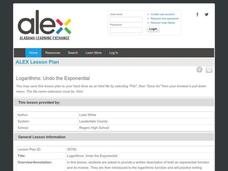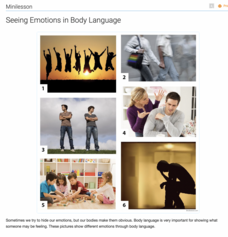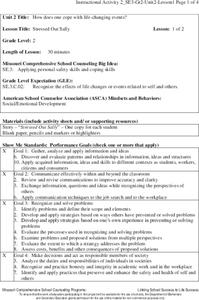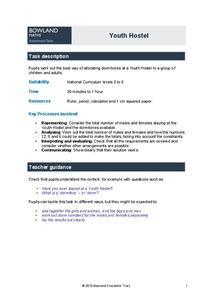Curated OER
Cartoons for the Classroom: 9/11 Revisited
Political cartoons about the September 11 terrorist attacks provide an opportunity for class members to analyze the inferences embedded in the drawings.
Curated OER
GLOBALIZATION
Students define the concept of the global community. They analyze characteristics of global communities using Stark's three categories: communication, economy, and culture/community. They write a five-paragraph essay which includes an...
Curated OER
Family Names
Young scholars draw a family tree. They label familiar items (e.g., family members, classroom objects, and pets). Pupils are given a copy of the worksheet "Family Name," they draw a family tree, label themselves and at least 10...
Curated OER
RESPONSIBILITIES OF OFFICE
Students make an organizational chart. They show the relationship of power in the executive branch of the Illinois state government. They include the responsibilities of each office and define the roles and responsibilities of top...
Curated OER
Human Genetic Disorder Probabilities
In this genetic disorders worksheet, high schoolers complete punnett squares for six different human genetic disorders. They predict the outcome of the offspring including the phenotypes and genotypes of each.
Curated OER
Measurement Worksheet
In this measurement worksheet, students fill in a chart with the proper SI units, measurements and symbols. They also practice converting from one metric unit to another. They express numbers in scientific notation.
Curated OER
WORKSHEET # 7 [4.1, 4.2, & 4.3], Exponent Review
In this algebra worksheet, pupils answer 37 multiple choice questions, each having to do with exponential operations. Twenty-five problems require students to multiply exponential terms. four problems involve dividing with exponents. 8...
Curated OER
Multiples of a
Sixth graders use problem solving strategies to evaluate linear expressions by substituting values. They substitute values for the letters in their names before applying the concept to other words. They complete worksheets in which they...
Code.org
Compound Conditional Logic
Scholars explore compound conditional logic and learn to use the Boolean operators AND, OR, and NOT within conditional statements by incorporating these operators to improve a previously created app.
Alabama Learning Exchange
Logarithms: Undo the Exponential
Rumor has it that an exponential can be undone. After playing a rumor game to model exponential growth, pupils learn about undoing exponential functions. They use the definition of the logarithm to convert exponential equations to...
EngageNY
Mid-Module Assessment Task - Algebra 2 (Module 3)
The 15th installment of a 35-part module is a mid-module assessment task. Covering concepts in the first half of the module, the task acts as a formative assessment, providing you with valuable information on how learners are doing.
Inside Mathematics
Party
Thirty at the party won't cost any more than twenty-five. The assessment task provides a scenario for the cost of a party where the initial fee covers a given number of guests. The class determines the cost for specific numbers of guests...
EngageNY
Replacing Letters with Numbers II
Teach about properties properly. Individuals investigate the commutative and identity properties for both addition and multiplication. They see that the properties hold true for all values by using substitution to test out several examples.
Charleston School District
Graphing Functions
How do letters and numbers create a picture? Scholars learn to create input/output tables to graph functions. They graph both linear and nonlinear functions by creating tables and plotting points.
5280 Math
Stories That Formulas Tell
Learn the stories a formula holds. An interesting lesson takes a unique approach to teach how to use formulas. Beginning with a formula, learners predict what the variables stand for and then use the formula to make calculations and tell...
Thoughtful Learning
Seeing Emotions in Body Language
Scholars test their skills of reading body language with a collaborative learning experience that focuses on showing and identifying emotions. Pairs take turns acting out an emotion, one uses body language while the other guesses what...
Missouri Department of Elementary
Stressed Out Sally
Life changes may cause stress. Here, scholars identify stressful situations in a peer's life and offer coping skills to make for a better day. A short story, "Stressed Out Sally," provides pupils with a look inside a bad day. After...
EngageNY
Recursive Formulas for Sequences
Provide Algebra I learners with a logical approach to making connections between the types of sequences and formulas with a instructional activity that uses what class members know about explicit formulas to develop an...
Curated OER
Multiplication: Bugs Can Multiply, So Can I!
Develop multiplication skills with your class. Youngsters will visualize multiplication as repeated addition. Then they will create a multiplication bug book and discover arrays as a strategy for multiplication problem solving....
Curated OER
Order of Operations
Some terrific practice in solving math equations that have a specific order of operations component built into them. Some of the problems have parentheses, and all four operations are present in the problems. Pupils solve 50 problems and...
National Research Center for Career and Technical Education
Business Management and Administration: Compound Interest - A Millionaire's Best Friend
Many math concepts are covered through this resource: percentages, decimals, ratios, exponential functions, graphing, rounding, order of operations, estimation, and solving equations. Colorful worksheets and a link to a Google search for...
Buffalo State
A Five Day Approach to Using Technology and Manipulatives to Explore Area and Perimeter
Young mathematicians build an understanding of area and perimeter with their own two hands in a series of interactive geometry lessons. Through the use of different math manipulatives, children investigate the properties of...
Bowland
Youth Hostel
Given a set of criteria, individuals determine how to arrange males and females in a dormitory. They must meet the requirements and communicate their plan clearly.
Thoughtful Learning
Using Positive Self-Talk
Boost positive self-talk with a chart that turns negative feelings into happy ones. Scholars write down their negative emotions then rewrite them with a positive flair to aid in changing their outlook.







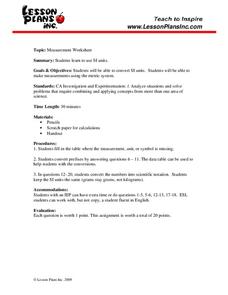
![WORKSHEET # 7 [4.1, 4.2, & 4.3], Exponent Review Lesson Plan WORKSHEET # 7 [4.1, 4.2, & 4.3], Exponent Review Lesson Plan](http://content.lessonplanet.com/resources/thumbnails/160773/large/cgrmlwnvbnzlcnqymdezmdmzmc05ntq0ltfuzgxmzgcuanbn.jpg?1414261468)


